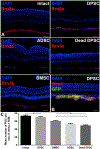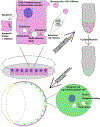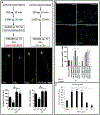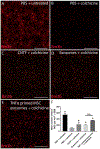Extracellular vesicle therapy for retinal diseases
- PMID: 32169632
- PMCID: PMC9460937
- DOI: 10.1016/j.preteyeres.2020.100849
Extracellular vesicle therapy for retinal diseases
Abstract
Extracellular vesicles (EV), which include exosomes and microvesicles, are secreted from virtually every cell. EV contain mRNA, miRNA, lipids and proteins and can deliver this expansive cargo into nearby cells as well as over long distances via the blood stream. Great interest has been given to them for their role in cell to cell communication, disease progression, or as biomarkers, and more recent studies have interrogated their potential as a therapeutic that may replace paracrine-acting cell therapies. The retina is a conveniently accessible component of the central nervous system and the proposed paradigm for the testing of many cell therapies. Recently, several studies have been published demonstrating that the delivery of EV/exosomes into the eye can elicit significant therapeutic effects in several models of retinal disease. We summarize results from currently available studies, demonstrating their efficacy in multiple eye disease models as well as highlighting where future research efforts should be directed.
Keywords: Exosomes; Extracellular vesicles; Glaucoma; Mesenchymal stem cells; Optic nerve crush; Retina.
Copyright © 2020 Elsevier Ltd. All rights reserved.
Figures







Similar articles
-
Extracellular vesicles in degenerative retinal diseases: A new therapeutic paradigm.J Control Release. 2024 Jan;365:448-468. doi: 10.1016/j.jconrel.2023.11.035. Epub 2023 Dec 2. J Control Release. 2024. PMID: 38013069 Review.
-
Circulating Extracellular Vesicles As Biomarkers and Drug Delivery Vehicles in Cardiovascular Diseases.Biomolecules. 2021 Mar 5;11(3):388. doi: 10.3390/biom11030388. Biomolecules. 2021. PMID: 33808038 Free PMC article. Review.
-
Socially Distanced Intercellular Communication: Mechanisms for Extracellular Vesicle Cargo Delivery.Subcell Biochem. 2021;97:179-209. doi: 10.1007/978-3-030-67171-6_8. Subcell Biochem. 2021. PMID: 33779918
-
Uptake and Distribution of Administered Bone Marrow Mesenchymal Stem Cell Extracellular Vesicles in Retina.Cells. 2021 Mar 25;10(4):730. doi: 10.3390/cells10040730. Cells. 2021. PMID: 33806128 Free PMC article.
-
RNA delivery by extracellular vesicles in mammalian cells and its applications.Nat Rev Mol Cell Biol. 2020 Oct;21(10):585-606. doi: 10.1038/s41580-020-0251-y. Epub 2020 May 26. Nat Rev Mol Cell Biol. 2020. PMID: 32457507 Free PMC article. Review.
Cited by
-
Stem Cell-Derived Exosomes: Natural Intercellular Messengers with Versatile Mechanisms for the Treatment of Diabetic Retinopathy.Int J Nanomedicine. 2024 Oct 24;19:10767-10784. doi: 10.2147/IJN.S475234. eCollection 2024. Int J Nanomedicine. 2024. PMID: 39469447 Free PMC article. Review.
-
Exosomes-based dual drug-loaded nanocarrier for targeted and multiple proliferative vitreoretinopathy therapy.Regen Biomater. 2024 Jun 29;11:rbae081. doi: 10.1093/rb/rbae081. eCollection 2024. Regen Biomater. 2024. PMID: 39040514 Free PMC article.
-
Circulating Small Extracellular Vesicles Involved in Systemic Regulation Respond to RGC Degeneration in Glaucoma.Adv Sci (Weinh). 2024 Aug;11(32):e2309307. doi: 10.1002/advs.202309307. Epub 2024 Jun 25. Adv Sci (Weinh). 2024. PMID: 38923329 Free PMC article.
-
Small extracellular vesicles derived from human induced pluripotent stem cell-differentiated neural progenitor cells mitigate retinal ganglion cell degeneration in a mouse model of optic nerve injury.Neural Regen Res. 2025 Feb 1;20(2):587-597. doi: 10.4103/NRR.NRR-D-23-01414. Epub 2024 Jan 31. Neural Regen Res. 2025. PMID: 38819069 Free PMC article.
-
Microbial Dynamics in Ophthalmic Health: Exploring the Interplay between Human Microbiota and Glaucoma Pathogenesis.Medicina (Kaunas). 2024 Apr 3;60(4):592. doi: 10.3390/medicina60040592. Medicina (Kaunas). 2024. PMID: 38674238 Free PMC article. Review.
References
-
- Rohde E, Pachler K, Gimona M, 2019. Manufacturing and characterization of extracellular vesicles from umbilical cord–derived mesenchymal stromal cells for clinical testing. Cytotherapy 21, 581–592. - PubMed
-
- Almasieh M, Wilson AM, Morquette B, Cueva Vargas JL, Di Polo A, 2012. The molecular basis of retinal ganglion cell death in glaucoma. Prog. Retin. Eye Res 31, 152–181. - PubMed
-
- Alvarez-Erviti L, Seow Y, Yin H, Betts C, Lakhal S, Wood MJA, 2011. Delivery of siRNA to the mouse brain by systemic injection of targeted exosomes. Nat. Biotechnol 29, 341–345. - PubMed
Publication types
MeSH terms
Substances
Grants and funding
LinkOut - more resources
Full Text Sources
Other Literature Sources
Medical

